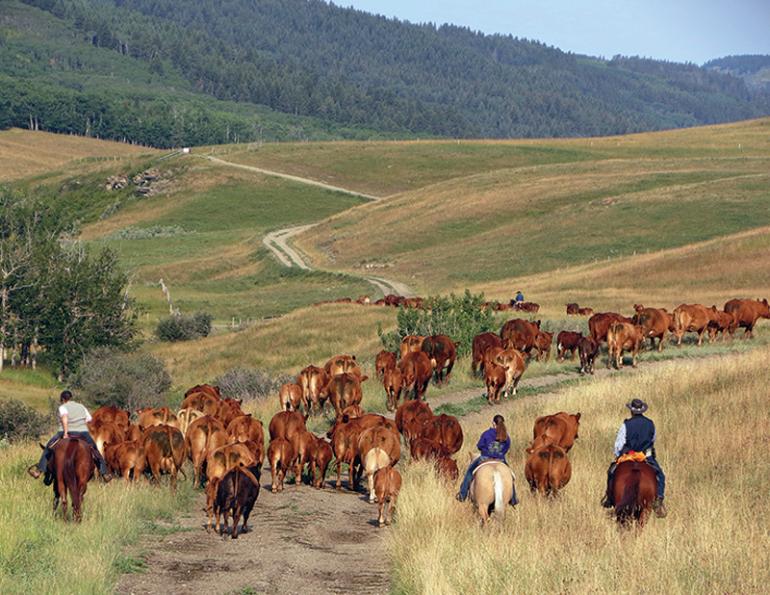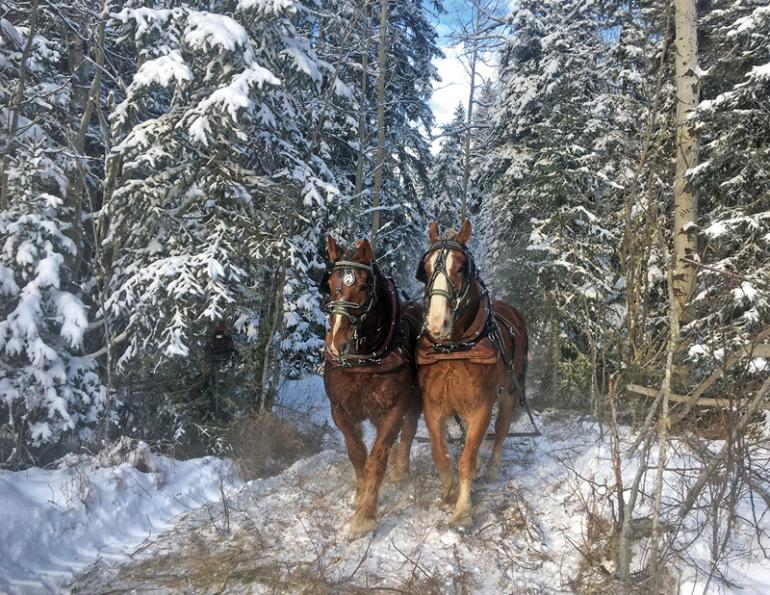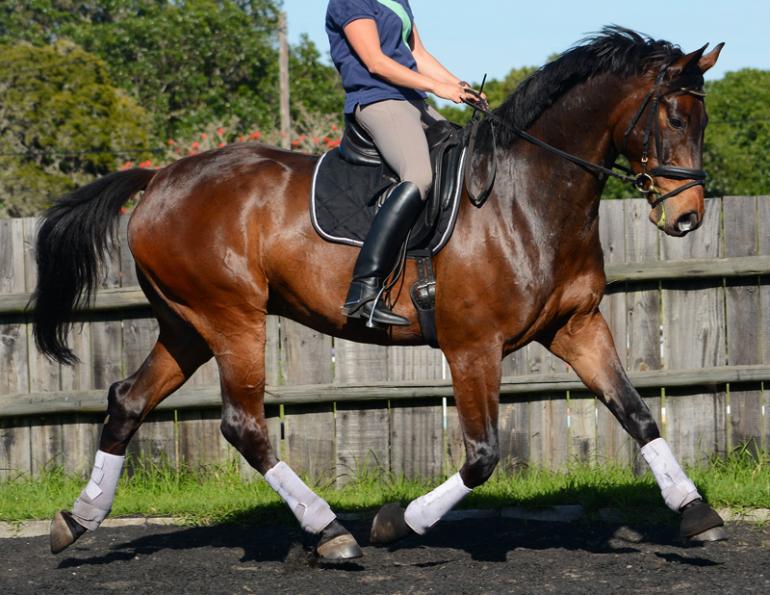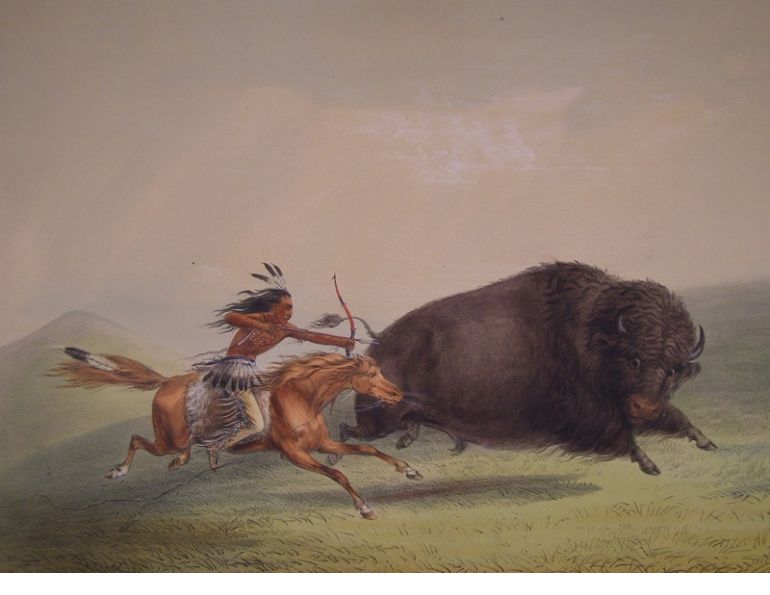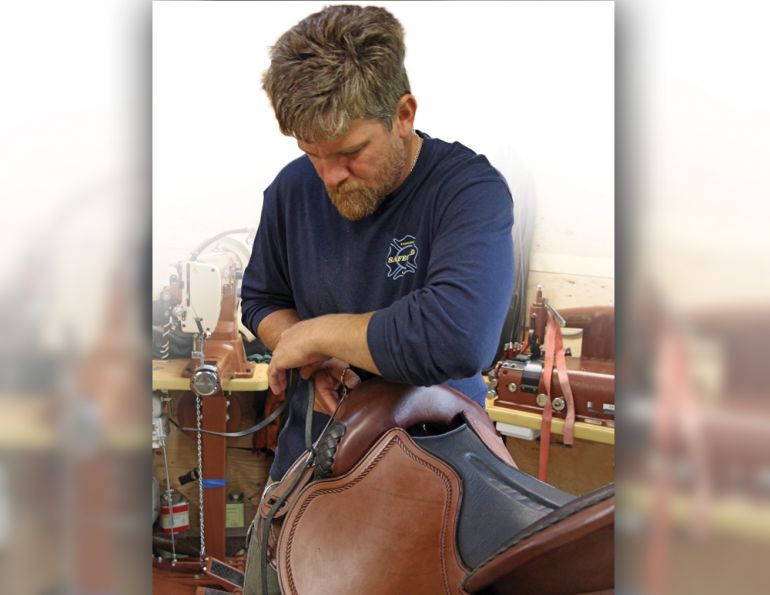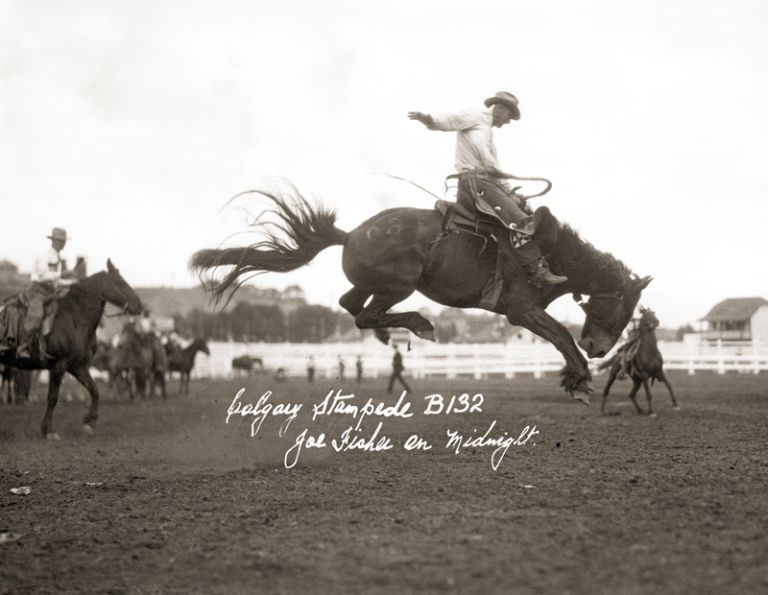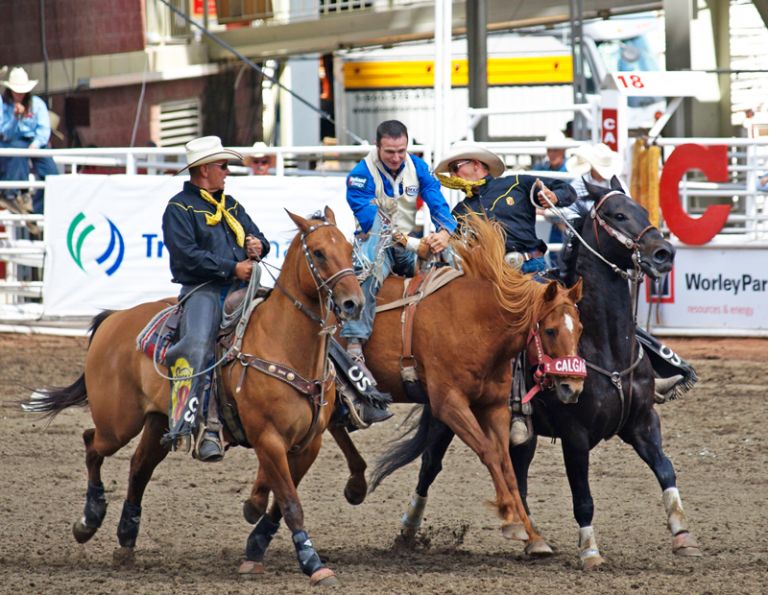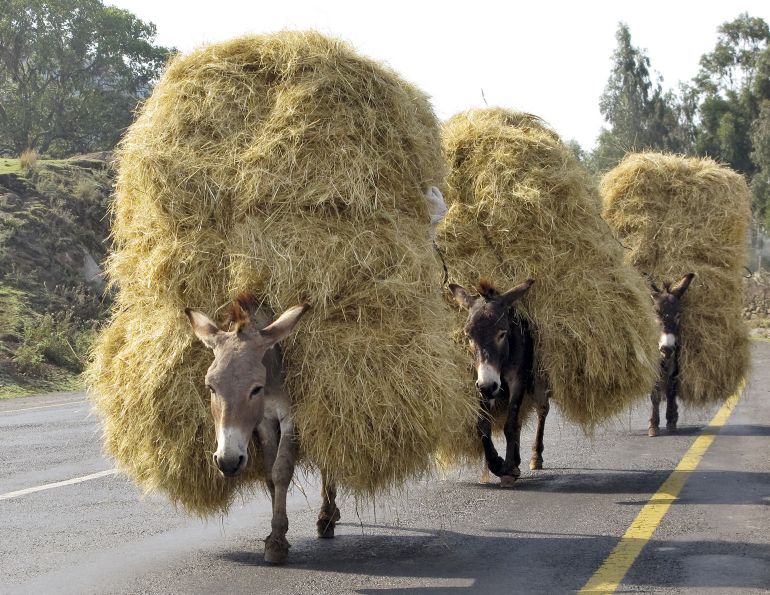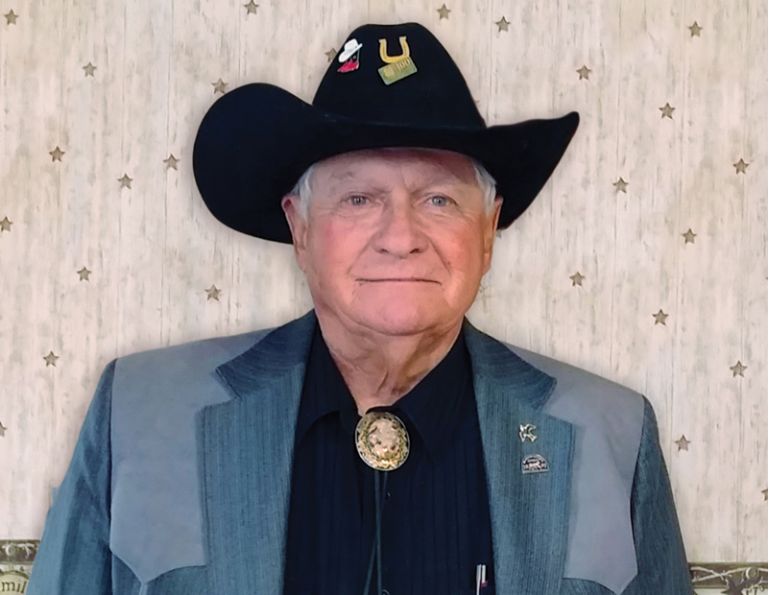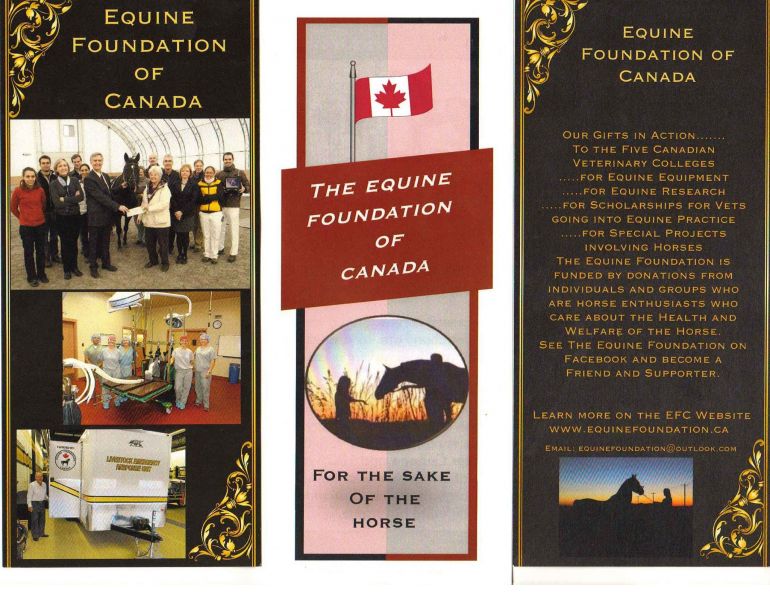Canada’s Ranching Heritage
By Margaret Evans
Canada’s cattle industry began long ago and far away, its tradition and history interwoven in the stories and folklore of explorers, fur traders, gold seekers and settlers.
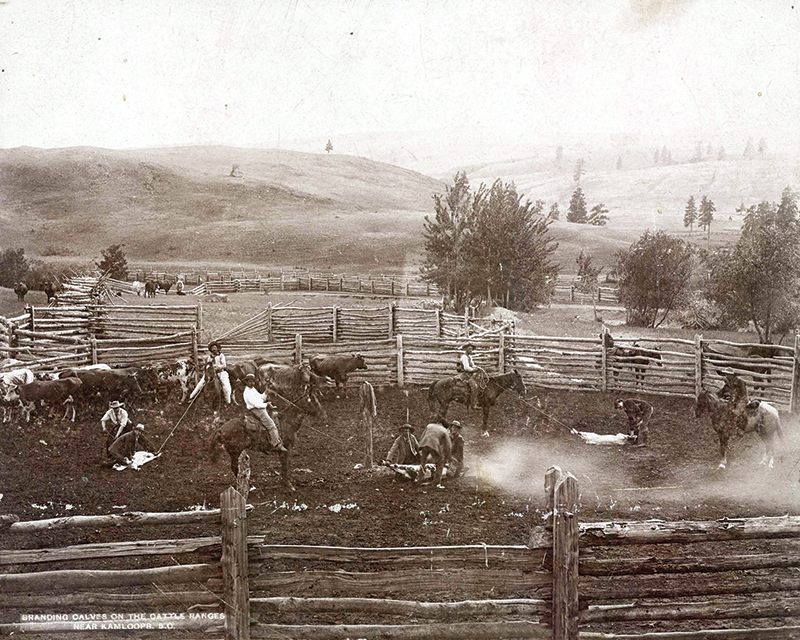
Cattle ranching in Canada has a long and fascinating history. This historic photo is titled “Branding Calves on the Cattle Ranches near Kamloops, BC.” Photo: Tourism Kamloops and Kamloops Museum.
For millennia, the vast region of western Canada was a land of pure, rich wilderness. Aboriginal tribes were hunter/gatherers and expert fishers whose environment defined their culture. Wildlife, especially fur-bearing species, was varied and hugely abundant.
Then, one misty February day in 1778, Captain James Cook on HMS Resolution dropped anchor off what would be the central Oregon coast. His men went ashore, met the locals and purchased beaver pelts and other furs. The transaction changed a way of life.
When Cook reached Oregon, the Hudson’s Bay Company was expanding from the shores of James and Hudson bays into central and western Canada. The company became dominant in the Pacific Northwest and had forts at Kamloops, Alexandria (near Quesnel), Langley, and Victoria. In 1825 they established Fort Vancouver on the Columbia River and appointed John McLoughlin as their Chief Factor. He would prove to be one of the most significant men in the region’s history. He advocated peace with native tribes, fair trade for furs, and self-sufficiency for workers. And he kick-started the cattle industry in British Columbia.
Hudson’s Bay trading posts were so remote that workers needed to grow their own fruits and vegetables and raise their own livestock. Since the company owned cattle in Oregon, John McLoughlin orchestrated the first cattle drive into the future British Columbia. According to Alastair McLean’s article in Rangelands (4)3, in 1846, the year the 49th Parallel became the Canada/US International Border, McLoughlin’s crew headed north, herding a supply of cattle and horses to forts Kamloops and Alexandria.
A decade later in March 1858, the first major gold strike in the Fraser River valley was made at Hill’s Bar. The news exploded as gold was discovered in the Thompson River watershed. By July, 33,000 prospectors and miners had beaten a path to the goldfields. Seizing a golden opportunity to provide food on the hoof, General Joel Palmer, who had been the Superintendent of Indian Affairs in Oregon, organized a cattle drive from Oregon through Osoyoos to the Thompson Valley. In 1859, he drove cattle to Fort Alexandria. Over the next decade, some 22,000 cattle were moved from Oregon to the Barkerville area.
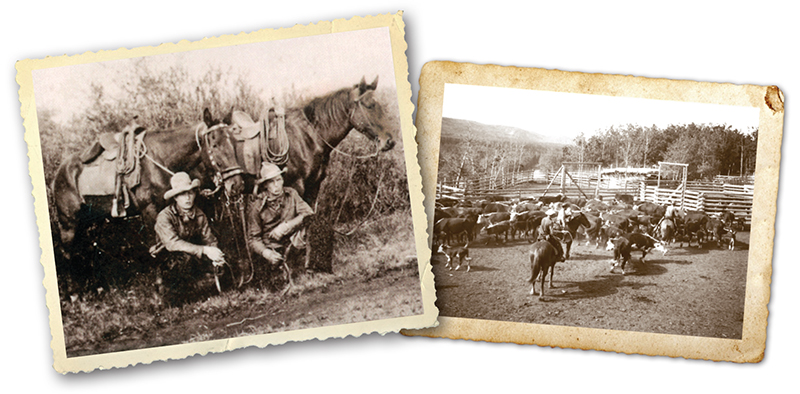
After the Cariboo gold rush of 1858, ranching became big business in BC, as people flooded up to the region. Brothers Art and Dude Lavington (left) came to BC to pursue their dreams, build their ranch, and raise their families in the Cariboo. Ardill Ranch (right), in BC’s Fort St. John area, was established in 1920. Today, it runs 350 cows and 30 Quarter Horses on 36 sections of land. Photos courtesy of the BC Cowboy Heritage Society
Cattle were moving into Alberta and, according to the University of Manitoba Archives and Special Collections, the first small herd was brought in by John and George MacDougall from Montana to Morleyville in 1871-1872. In 1874, the North-West Mounted Police detachment became a boost for ranching, providing security and a local market. Soon, great cattle ranges were dominating western Canada: the Gang, Douglas Lake and Empire Valley ranches in British Columbia, the Cochrane, Bar U, Oxley, and Walrond ranches in Alberta, and the “76,” Hitchcock, and Matador ranches in Saskatchewan.

Born in 1901, Eddie Bambrick was cowboss at Alkali Lake Ranch at the age of 21, then ranch foreman responsible for 8,000 cattle at The Gang Ranch, and later worked at Chilco Ranch. This photo shows Bambrick moving cattle to the bridge at Farwell Canyon, southwest of Williams Lake, BC. Photo by Earl Cahill, courtesy of the BC Cowboy Heritage Society.
In BC, all roads led to the Cariboo. Rest stops, roadhouses, and roadside inns provided food and lodging. They all had a cow or two in the back forty and those early entrepreneurs quickly connected the dots and saw a fortune in beef. Many who came as prospectors, miners, pack train operators, surveyors or drovers preempted land to become cattle ranchers.
Fifty kilometres southwest of Williams Lake lay a beautiful valley the early settlers, explorers, and wanderers called Valley of the Waving Bunchgrass, or Paradise Valley. It became home to British Columbia’s Alkali Lake Ranch, the province’s very first cattle ranch. It was founded in 1861 by German-born Herman Otto Bowe, and the ranch stayed in the family until 1909 when it was sold to Englishman Charles Namby Wynn Johnson, grandfather of Charles “Chunky” Woodward. Over the next 30 years, Johnson increased his holdings by buying out various neighbours as he piloted the enterprise through the tough times of World War I and the Great Depression years. The ranch changed hands several times again until, in 2008, it was sold to the Douglas Lake Cattle Company, which Chunky Woodward himself owned from 1959 until his death in 1990. It is now owned by E. Stanley Kroenke, a Missouri and Colorado-based businessman.
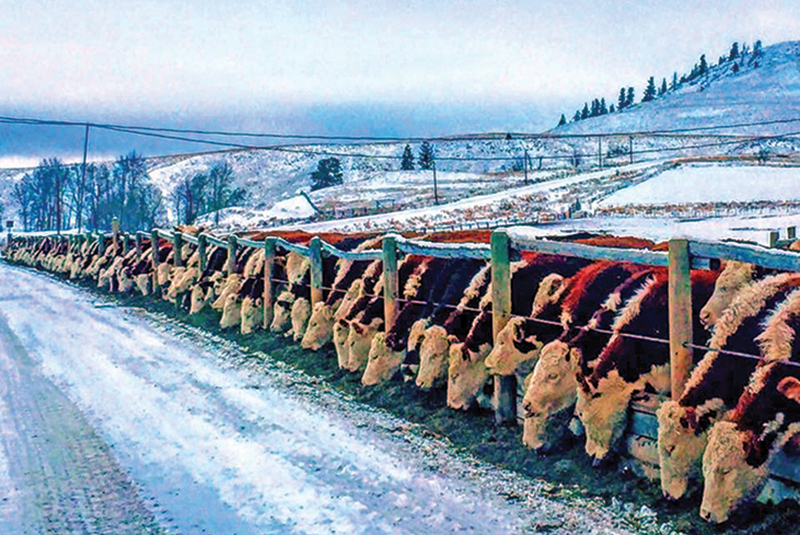
The total cattle herd at Douglas Lake Ranch is approximately 20,000 head at present. The base herd consists of approximately 4,500 Hereford cows and 2,500 Black Baldie cows and 450 bulls, producing about 6,600 calves each year. Photo courtesy of Douglas Lake Ranch.
“Currently, Douglas Lake Cattle Company consists of our operations at Douglas Lake, which as of 2013 include the Quilchena Ranch, which added over 27,000 acres to our original 164,000 deeded acres,” says Phil Braig, assistant manager of the ranch near Merritt, BC. “In 2008, we also purchased the historic Alkali Lake Ranch, which was made up of 37,000 private acres and in 2012, we added the neighbouring James Cattle Company, which consisted of approximately 20,000 acres. As of January 1, 2016, we purchased the Riske Creek Ranch located across the river from Alkali Lake Ranch, which added another 23,000 deeded acres and 9,500 leased acres to our holdings. In total, we now manage approximately 271,000 private acres and over 1.3 million Crown grazing acres, bringing our total managed acres to well over 1.5 million acres.”
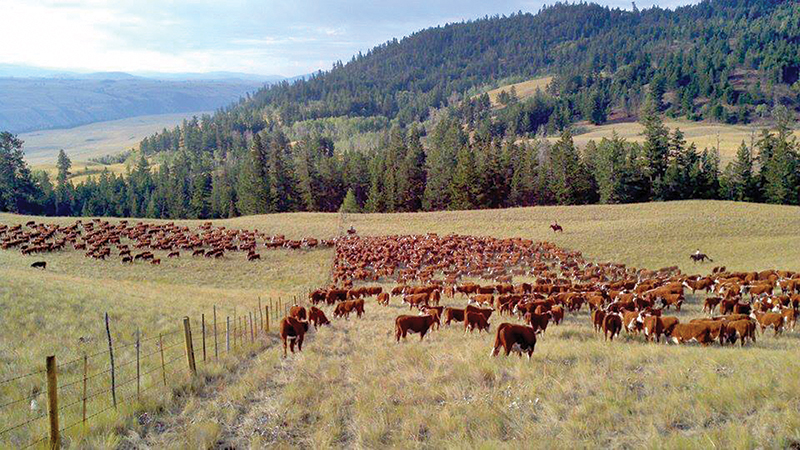
Douglas Lake Ranch sustains an impressive herd of cattle through careful management of the natural grasses including indigenous Bluebunch Wheatgrass. Photo courtesy of Douglas Lake Ranch.
Douglas Lake Ranch traces its name back to 1872 when John Douglas Senior homesteaded his first 320 acres along the lakeshore. In 1884, he sold the property to Charles Beak who, along with his partners, founded the Douglas Lake Cattle Company on June 30, 1886.
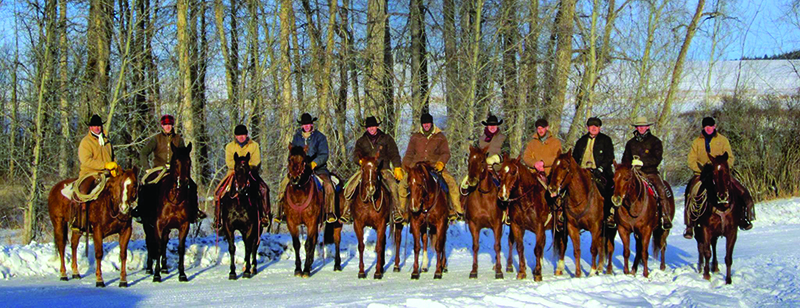
A staff of 16 to 18 cowboys are responsible for the well-being of the Douglas Lake Ranch herd. Each cowboy has a string of about ten horses that they rotate throughout the year. The ranch maintains approximately 300 Quarter Horses, which are bred on the ranch for quality and cow sense. Photo courtesy of Douglas Lake Ranch.
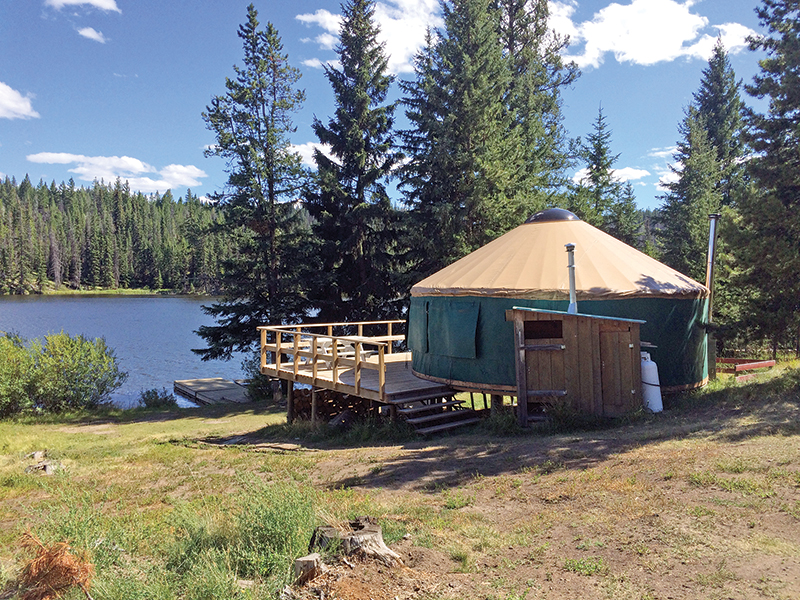
Douglas Lake Ranch has five yurts where visitors can enjoy a peaceful, lakeside stay. Photo courtesy of Douglas Lake Ranch.
The year 1886 was significant. It saw the first transcontinental train trip of the Canadian Pacific Railway. Ranchers began shipping beef to Great Britain in 1887.
In the Okanagan, ranching began in the 1860s when Charles Frederick Houghton claimed a military land grant that would become the nucleus of the Coldstream Ranch. According to the Vernon Museum and author Donna Wuest’s book Coldstream: The Ranch where it all Began, in 1863 when Houghton arrived in Esquimalt, Governor James Douglas had reduced land claims to just 300 acres. Houghton learned of some good land at the north end of Okanagan Lake, and in 1864, staked a claim along the banks of a stream he called Coldstream Creek because of the many cold water streams that flowed into it. When military grants were restored to their original size, he was able to claim an additional 1,150 acres.
The ranch changed hands when Houghton traded it with the Vernon brothers for property in Okanagan Landing. They made many improvements and expansions before Charles Vernon sold his share in the 13,261 acre property to his brother Forbes in 1883.
In 1890, Lord and Lady Aberdeen visited Canada and were impressed with the potential for fruit growing in the Okanagan. According to the Coldstream Ranch website, “In October 1891, the Aberdeens purchased the Forbes Vernon Ranch of 13,261 acres, 2,000 cattle, 19 work horses, 43 range horses, 70 hogs, 70 sheep, 50 head of poultry, and everything movable for ten thousand pounds down and forty thousand pounds to be paid over two years at six percent interest.”
They renamed the property Coldstream Ranch and, before returning home, they left instructions with ranch managers to plant apple, pear, and cherry trees, as well as hops. The 25,000 fruit trees and hops planted on the ranch in 1892 marked the beginning of commercial fruit growing in the Vernon area.
Today, the ranch consists of 7,500 deeded acres and approximately 350,000 acres of range.
“We have 2,100 cows and background 4,500,” says Brad McKim, general manager. “We have 50 horses and employ 15 people year round and 22 in the summer. It is strictly a working ranch and grows corn, alfalfa, and grass on 1,700 irrigated acres.”
McKim explains that there are essentially two operations in one. “We have a cow/calf operation, which includes the 2,100 cows. They calve out in the spring. The ranch owner buys some calves in the fall, adds our own, and we put them into the feedlot. Backgrounding is the developmental stage between calf and finishing stage. It is where they develop bone and muscle structure.”
In the latter part of the 1800s and the first decades of the 1900s, ranches continued to spring up across Western Canada.
“My ranch started in 1920 when my grandfather settled here,” says Irene (Renee) Ardill of Ardill’s Ranch in BC’s Fort St. John area where they run 350 cows in a cow/calf operation on 36 sections and maintain 30 head of working Quarter Horses. “He came from Ireland to Canada and worked in Cache Creek as a surveyor for a while. He joined the Canadian Army, served in World War I and was wounded. While recovering, he met his wife and returned to Canada. He had heard about the Peace River country from a friend who told him that if he survived the War he should go to the Peace.”
“The Bar U Ranch (near Longview, Alberta) was established as the North West Cattle Company in 1882 and was among the first of four large corporate ranches in southern Alberta,” says Michael McLean, Product Development Officer-Special Projects with Parks Canada. “Bar U cattle fed the world and in the early years of the twentieth century had established the largest Percheron breeding operation of its kind. In 1890, the Bar U reported just over 10,000 head of cattle and about 800 horses. The original 1882 lease was for 147,000 acres and was expanded just prior to George Lane purchasing the ranch in 1902. Under Lane, and later on Pat Burns, the Bar U was a part of a network of ranches each owner operated. In Burns’ day (1927-1950), it was said a rider could travel from Calgary to the US border and not leave Burns’ land. The Bar U Ranch was the most successful and longest lasting of the first four founding ranches.”

Visitors to the Bar U Ranch National Historic Site (left) enjoy a guided tour of the many heritage buildings while learning about the ranch’s rich history. Established as the North West Cattle Company in 1882 (right), the Bar U Ranch saw many colourful characters over the years including Harry Loungbaugh, aka The Sundance Kid, who worked at the ranch in the early 1890s. Today the Bar U Ranch, the longest lasting and most successful of the first four founding corporate ranches in southern Alberta, is a National Historic Site run by Parks Canada. Photos: Parks Canada (left); Norman Mackenzie (right)
Colourful characters visited the ranch over the years. According to McLean, Harry Loungbaugh, also known as the Sundance Kid, worked as a horse breaker on the Bar U in 1891. He was hired by foreman Everett Johnson (on whom, it is believed, author Owen Wister based his main character in “The Virginian”).
“The “Kid” seemed to have spent a quiet time in Alberta, although one old timer wrote he always kept a hacksaw blade hidden in the cantle of his saddle referencing a rustling background,” says McLean. “The blade could be used as a ‘running iron’ to alter cattle brands. The Kid was acknowledged as a ‘hand’ although a cruelty to animals charge was brought up against him, but he was never prosecuted. He did save a local rancher during a cattle drive in a blizzard when he went back to find the rancher after he lost his way at the rear of the herd.”
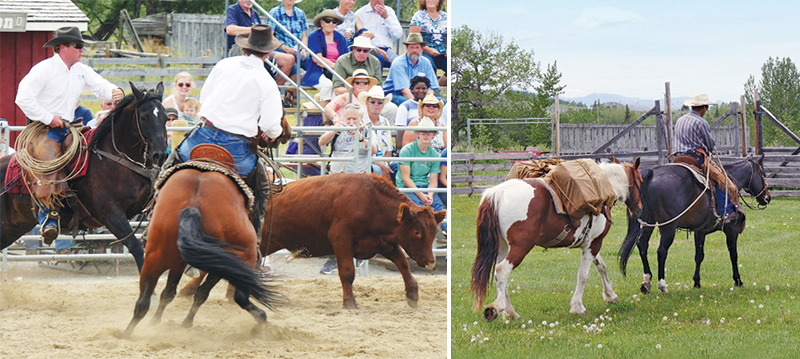
Traditional ranching and packing skills are on display for visitors to the Bar U Ranch, a historic working ranch and the only site in Canada to commemorate ranching history. Photo: Parks Canada
Edward VIII Prince of Wales visited the ranch in 1919. He arrived by rail in High River and a motorcade brought him out to the Bar U just before suppertime. McLean says that legend has it, Edward went for a jog up the creek and discovered the neighbouring Bedingfield Ranch. Before he left Canada, he arranged for Bar U owner George Lane to purchase the ranch for him. Edward owned the former Bedingfield Ranch, now known as the E.P. (Edward Prince) Ranch, until 1962. He stocked his ranch with many purebred livestock breeds that were a boon to local agriculture, giving farmers and ranchers access to breeding lines they would not otherwise have had.
“The Prince only made a few visits to the ranch,” says McLean. “My father remembers the last, probably in 1942. Farmers were stationed at various mud holes on the Bar U Trail from High River to the ranch with either teams or tractors to assist the motorcade if necessary. My father remembers peeking around a potbelly stove at South Fork Trading Post, our local Post Office and General Store about five kilometers east of the Bar U, to see the Prince (then the Duke of Windsor) on a pit stop.”
Acclaimed artist Charlie Russell visited the ranch in 1888 where a friend had just secured a job. Russell explored the area and created art inspired by what he saw or tales he heard. A story from George Lane about riding into a pack of wolves with a six-gun blazing inspired a picture by Russell, which was later the inspiration for a bronze statue of Lane that stands just outside the Visitor Centre.
“Another notable figure from history is John Ware who graces a Canadian postage stamp and has twice been honoured during Black History Month,” says McLean. “A former slave, Ware learned about horses and cattle in Texas and helped bring in the first herd of cattle to the Bar U. He worked on the Bar U and a neighbouring ranch before starting his own operation first in the Millarville area and later near Duchess. When Ware (an expert horse trainer) was hired for the cattle drive, the boss was a bit skeptical about his abilities and gave him an old saddle and a worn out horse. Ware rode uncomplaining, but at the end of the day asked his employer for a ‘little worse horse and a better saddle.’ Ware passed away after a fall from a horse in 1905. His funeral in Calgary was the largest the young city had ever seen.”
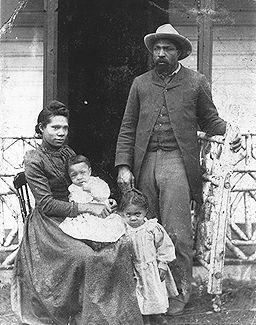
John Ware with his family, circa 1897. John Ware was born into slavery on a plantation near Georgetown, SC. Freed after the American Civil War, he learned ranching and cowboy skills in Texas and became a master horseman before making his way to Canada. He is best remembered for bringing the first cattle to southern Alberta in 1882, helping to create that province’s ranching industry. Photo: Wikimedia
Today the Bar U Ranch National Historic Site is run by Parks Canada and ten horses call the ranch home. Eight are Percherons used for shuttling guests by wagon to and from the Visitor Centre on to the National Historic Site during the summer season from May 16 to September 30. The Percherons are also used for outreach such as participation in local parades as well as the Calgary Stampede Parade and are on display during the Stampede. There are also two Quarter Horses that are used to help manage the cattle herd as well as in interpretive programs for guests. The cattle include 32 cows and calves.
“The cow/calf operation is operated by our volunteer organization, the Friends of the Bar U Historical Ranch Association,” says McLean. “The calf crop is sold at market each fall. The herd grazes on the 367 acres of the National Historic Site. About 80 acres of the site is devoted to feed production, which the Friends group contracts to harvest. Grass and weed management is governed by Parks Canada Policy. The horses are maintained by the Bar U Ranch National Historic Site.”
Large or small, grassland management on ranches is always a huge issue.
“Our native grass is predominantly blue bunch wheatgrass, which is well suited to our hot dry climate; however, it is highly susceptible to over-grazing, damage from vehicles and equipment, and prone to noxious weed infestations,” says Braig at Douglas Lake. “Therefore, we treat our grasslands with the utmost care, restricting as much vehicle travel over it as we can to stop the introduction of weeds and minimize damage. We generally graze approximately 50 percent of the mature height of the plant to ensure strong regrowth. We also have a large noxious weed mitigation program in place, spraying over 500 acres annually.”
The ranch has approximately 10,000 mother cows, 4,500 yearlings, 500 bulls, and 350 horses.
“Our cow herd consists of a straight Hereford base herd and a 50 percent black Angus/50 percent Hereford crossbred cow, which we terminally cross with Charolais bulls to produce a terminal calf.” By terminal, Braig means that these calves are sold and none are retained as replacements in the herd.
Ardill couldn’t agree more about the need for range management. “The land is everything,” she says. “It’s hard to describe your connection. Everything revolves around the land. I have a good friend who comes out here. It was calving time. I kept looking for the grass, the first tiny sign of growth. She wondered what all the fuss was about then said, ‘I suppose grass is pretty important.’ I told her that it’s everything. Without grass you have nothing.”
One of the early ranches in Alberta was the Circle L Ranch. It was established in July 1881 in the Porcupine Hills northwest of Fort Macleod by Captain Charles Augustus Lyndon and his wife Margaret.
Arriving from Salt Lake City, the Captain met with an aboriginal man called Doodney and toured the hills with him. Doodney took a special liking to the Captain’s pinto horse so they came up with a deal. If Doodney could find some land to the Captain’s liking with plenty of good grass, water and shelter, he could have the horse. In a few days, they found a site that had long been used as a camping ground by native tribes. It was perfect to set up a ranch.
The Lyndon’s purchased a few head of cattle and the Circle L cattle brand was granted to the Captain. It was considered one of the first brands given to a homesteader. In 1886, a house and barn were built and a big barn was built in 1919, which still stands. The Lyndon family owned the ranch for 85 years until it was sold in 1966. Then in 1974, the Lucas family purchased the ranch – but not the Circle L brand - and it became the Lucasia Ranch.

Gathering the herd at Lucasia Ranch through the picturesque Porcupine Hills of southwestern Alberta. Photo courtesy of Lucasia Ranch.
“The original deal was to have the Circle L brand go with the sale of the ranch,” says Judy Lucas who owns the ranch with her husband, Wayne. “At the last minute, he (the previous owner) decided to keep the brand. My son was able to buy the brand as a horse brand but does not use it anymore. Usually you find a brand you like and make application to the brand office. It used to be that it contained a letter and numbers but they have since opened it up to use old brands and symbols. It is often something you inherit from family.”
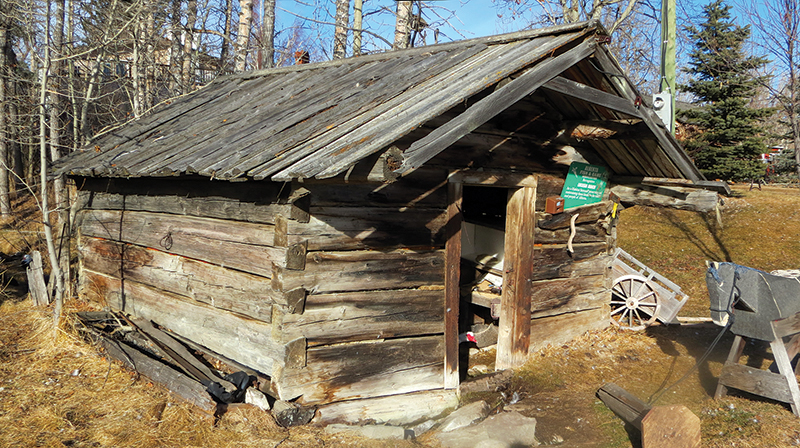
A heritage building on Lucasia Ranch near Claresholm, Alberta. Photo courtesy of Lucasia Ranch.
The Lucasia Ranch spans 4,000 acres with one third of it being grazing leases. A grazing lease is an agreement between a rancher and the provincial government in which the rancher cares for a tract of public land in exchange for the right to graze his cattle on it. The ranch is a cow-calf operation with 260 cows plus a small herd of longhorns. They raise and show Percheron horses and 60 of them intermingle with wildlife on the ranch. However, 25 horses are maintained for guests who vacation at the ranch.

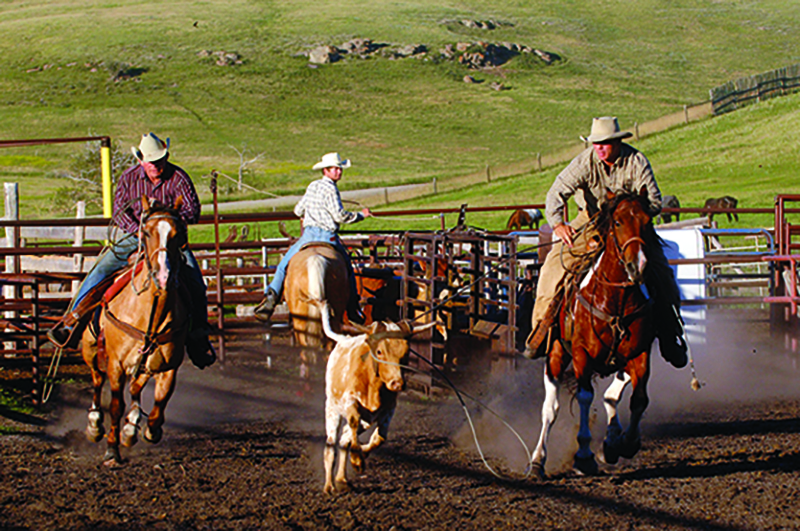
Branding at Lucasia Ranch. The ranch’s cow-calf operation has 260 cross-bred cows and a small herd of Texas Longhorns, in addition to their Percheron, Appaloosa, and Quarter Horses. Photos courtesy of Lucasia Ranch.
“With the downturn of cattle prices and BSE [bovine spongiform encephalopathy] some years ago, it was difficult for ranches to make a good living,” says Lucas. “We started the ranch vacations to supplement the ranch income. The vacations have helped us for the last 22 years and we cater to guests from all over the world. They enjoy the lifestyle and cattle work that we provide them. Our slogan tells most of the story, ‘Sharing our Western Heritage.’”
Of the 400 to 500 guest nights they do a year, 80 percent come from Europe. The Lucases are immensely proud of their history and love showcasing the ranch and the Porcupine Hills to visitors.
The famous Gang Ranch in the Chilcotin region of BC’s Central Interior had its beginnings as the Canadian Ranching Company. It was founded by Jerome and Thaddeus Harper, brothers from West Virginia who got the gold fever and rode into British Columbia from California, picking up the Cariboo Trail to the gold fields. But if they saw wealth in gold, they saw greater wealth in cattle. Cattle valued at $10 south of the border could go for $100 a head in BC. They found perfect bunchgrass grazing land west of Clinton. They settled the land, obtained a Crown grant for 160 acres, and drove a herd of 500 cattle from Oregon and Washington to the Cariboo.
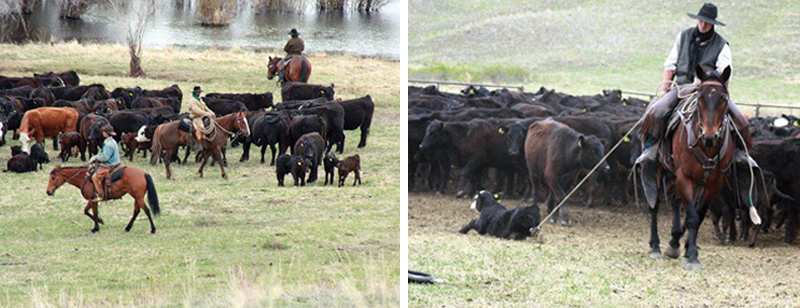
Sorting cattle and calves after branding at the Gang Ranch (left). A ranch horse drags a calf for branding (right). Each spring, over 2,000 calves are branded at the Gang Ranch. Photos courtesy of Gang Ranch.
How the ranch became named Gang Ranch has always been a bit of a curiosity.
“The best explanation would be that around the turn of the century when the Gang Ranch was being developed, mostly by English owners, they brought in horse-drawn plows to start hay production,” says Larry Ramstad, ranch manager. “They were called gang plows. The Gang Ranch was probably the first ranch to use them. Another explanation is that when they were digging irrigation ditches, they had large gangs of Chinese labourers for manual work. This was in the late 1800s or early 1900s after the railroads were done and the Chinese were looking for work on ranches.”
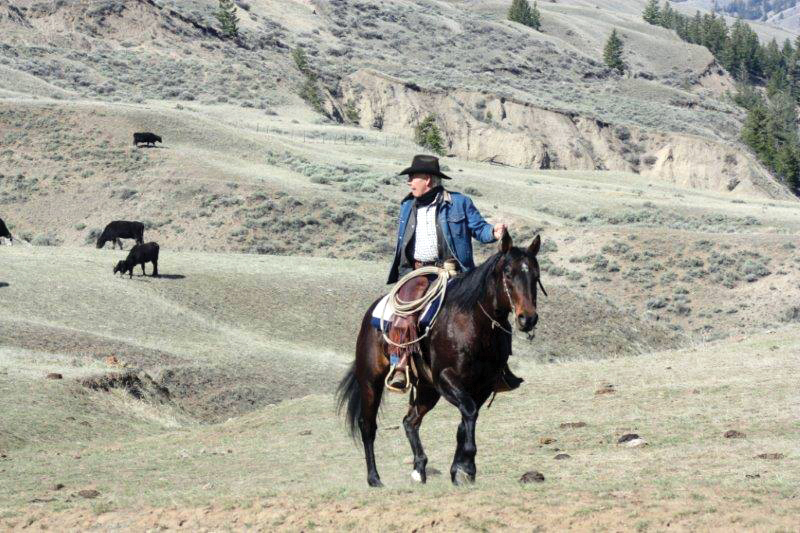
Larry Ramstad, manager at the Gang Ranch, checking herd during spring turnout. Photo courtesy of Gang Ranch.
Over the decades, the ranch changed hands a number of times, fell on hard times, went into receivership, and was eventually purchased by Sheikh Ibrahim Afandi of Saudi Arabia in 1987. The Sheikh’s company has wide ranging interests in renewable energy, information technology, healthcare, real estate, tourism, and farming.
“He comes out occasionally, but hasn’t been here for some time,” says Ramstad. “Every time he’s been here he asks to go to a particular site by the Chilcotin River on the north boundary where glacial water runs right by his private land. There is no running water in Saudi Arabia so, for whatever reason, this river interests him.”
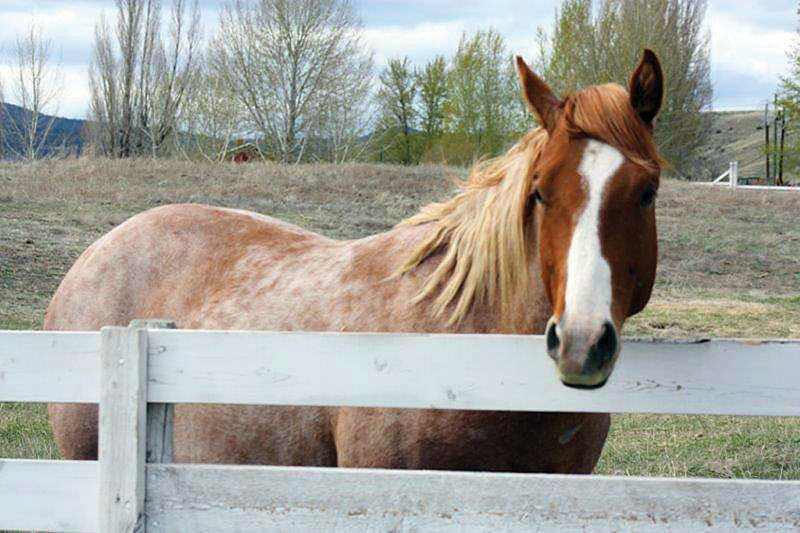
One of the Gang Ranch’s replacement stallions, whose lineage goes back to the Freckles Playboy Quarter Horse line. Photo courtesy of Gang Ranch.
The Gang Ranch today is a million acres in total usable area. It is comprised of 30,000 acres of private land and the balance is held under a grazing permit on Crown land. The ranch has about 2,500 cows and some 120 horses. There are eight to ten cowboys on the ranch. They all have strong riding skills and their sound knowledge of cattle is central to livestock management. But cowboys are becoming harder to find.
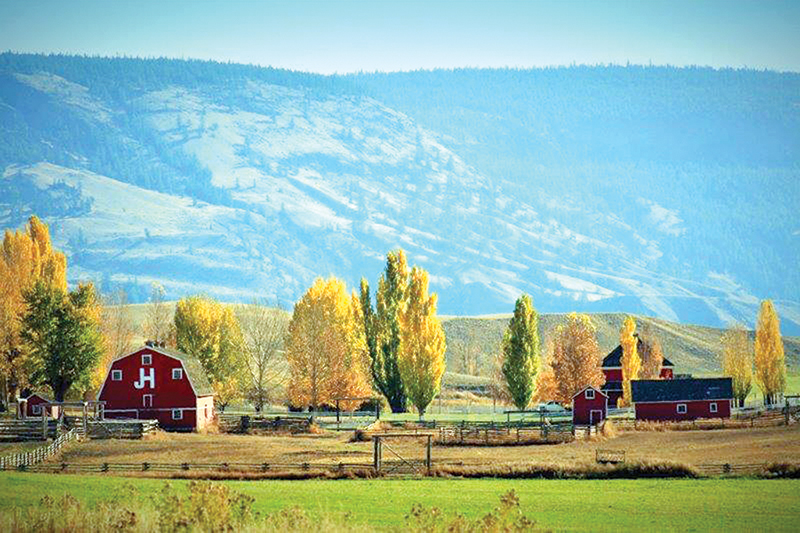
Gang Ranch in fall colours. Photo courtesy of Gang Ranch.
“It’s hard and they are getting more and more difficult to find,” says Ramstad. “Many are not willing to work in a range situation, which is more challenging. They need to have a good connection with horses and cattle, be willing to put in the long hours, and deal with all kinds of weather conditions. They must be comfortable working alone, be self-motivated, have patience as things don’t always go as planned, and have skills that are very specialized, whether roping or riding or handling stock. It’s not something they learn in a week or two and they must be able to adjust.”
Ramstad says that the horses on the ranch are 100 percent Quarter Horses. They are 15 hands or taller with good solid feet, good conformation, good levels of endurance so they can work the hours needed, and great minds. They are from the old Hancock breeding line or the Doc O’Lena line of Quarter Horses that excel in cutting. “They have size, cattle savvy, and intelligence,” he says.
Throughout the decades, ranching families depended heavily on horses for cattle maintenance and control. Riding horses, they welcomed the rhythms of the seasons – spring calving and branding, summer grazing in the high country, haymaking for winter feed, ranch maintenance jobs such as fence checking, fall gathers, and sorting calves for those to be sold at auction or over-wintered with the core herd. While some ranches have become motorized using ATVs to check stock, most ranches still rely on dependable, working horses to get to areas where machinery simply can’t. Plus, their intelligence and savvy about their surroundings can be a lifesaver.
A horse’s instincts can warn a rider of other animals in the area, the presence of eagles, vultures, or ravens, and the scent of a predator. A horse will instinctively read the landscape and cue on subtle signs that will draw the attention of a seasoned cowboy. A horse is much more compatible for moving and working with cattle. A level-headed horse can think for itself and navigate through bush in pursuit of a lost cow or calf. If a rider gets into a bad spot, a good horse will get him out of it. Not every horse has cow sense, but the intelligent ones are willing to learn and figure things out, and they can make a perfect match for the rider.
In Ardill’s opinion, a Quarter Horse is probably the best ranch horse because they have so many of the desired qualities. But she also recognizes the value of cross-breeds, especially a Quarter Horse/Thoroughbred cross. “They have a lot more endurance,” she says. “They are tough but the breed mix takes the edge off.”
The need for a horse with endurance is a universal quality. Ardill also values good conformation as it underlies a horse’s ability to stay sound.
“They will carry a saddle properly and it won’t roll around,” she says. “A lot of people are going to ATVs, but they will never replace a horse in rough country or bush. On our ranch it doesn’t work,” she explains, sharing the following example: “A neighbour had a bunch of heifers. One of the guys moving them was on a horse. The heifers went into the bush and he went after them. The owner was on an ATV and he couldn’t get in there, but you could hear where the cows were by the guy cussing on his horse.”
Along with valuable horses are invaluable dogs.
“All the men will have dogs,” says Ramstad. “They are border collies. They are mostly used during the fall gather and not so much when cows have young calves so as not to agitate them.”
A good cattle dog will find lost cows in the bush and alert the cowboy to its location so that the animal can be retrieved and checked.
The Gang Ranch also uses aircraft for aerial surveys and Ramstad is seriously looking at the value of drones. “We have an air strip but don’t have a plane,” he says. “We hire a local pilot with knowledge and experience of backcountry and he uses a fixed-wing. Once a year we do a survey with a helicopter. We can cover a lot of country and can land easier. We are definitely considering drones and looking at different types (in terms of) flying time, distance, and flying height. There is a definite future use for them.”
While the Gang Ranch is strictly a working ranch and remote in its location, other ranches such as Douglas Lake offer various levels of tourism as a division of their operation. Douglas Lake caters to over 4,000 visitors a year.
“The ranch employs anywhere from 100 to 140 employees depending on the time of year,” says Braig. “Our seasonal positions are on the summer farm crew and in our recreation division, which consists of Salmon Lake resort, which caters to campers and RV's, Stoney Lake Lodge, which is our higher end fishing destination, and various other camping/fishing lakes. We also operate a hotel and RV park at Quilchena located on Nicola Lake. All of our recreation facilities except for our hotel are geared toward fly fishing.”
Unique to a lakeside stay is accommodation in the ranch’s yurts. The design of these circular tents originated with Mongolian people who could quickly put them up and move them from one location to another. Canvas covers a sturdy lattice frame and they are insulated with a steep roof that comes together in a skylight dome. The ranch has five yurts in four different locations.
Ranchers and the cowboys who ride the range have a deep and abiding connection to the land. Some ranchers approaching retirement years consider that the land they have cared for should be cared for permanently in the future.
In 1996, the Nature Conservancy of Canada in Saskatchewan acquired the Old Man on His Back Ranch from Peter and Sharon Butala whose family had homesteaded the ranch site since 1913. It had been run primarily as a cow/calf operation with some cultivation. The 13,095-acre ranch is characterized by vast mixed prairie grasslands and features of cultural, historical, and ecological significance.
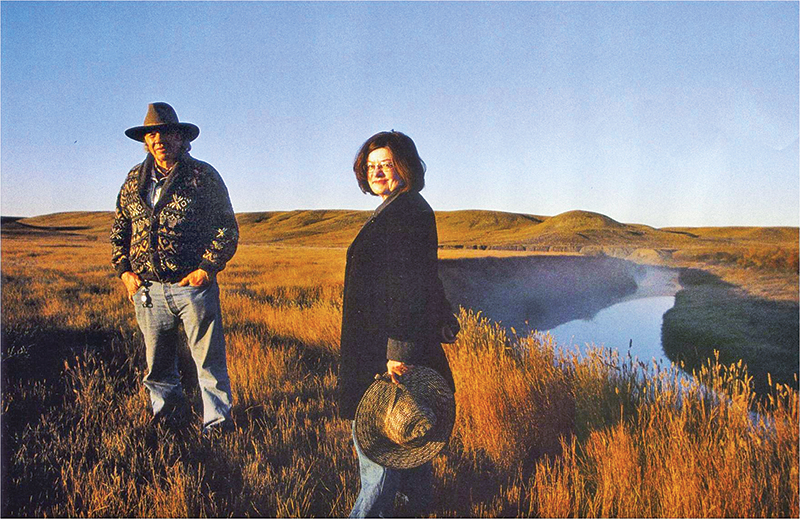
The Nature Conservancy of Canada acquired the Old Man on his Back Ranch from Peter and Sharon Butala in 1996. The Butala family had homesteaded the ranch site since 1913. Photo: NCC
For centuries, herds of thousands of bison roamed the grasslands. Ancestors of the Nikaneet Cree depended on them for every aspect of their life and culture. Medicine wheels and teepee rings are still found on the ranch as testimony to their importance in the past. The North-West Mounted Police also pastured their horses on the property. While the Nature Conservancy of Canada (NCC) manages the range for grassland conservation and wildlife protection, the range also benefits from sustainable cattle grazing.
“NCC offers grazing lease agreements to a limited number of local patrons at Old Man on His Back (OMB),” said Natalie Hassett, natural area manager, southwestern Saskatchewan. “We run about 200 head of cattle from June 1 to October 15. OMB is a bit unique for the NCC as it is almost run as a community pasture, where myself and assistant contractors are in charge of the management of the cattle while they are at OMB (fencing, moving the cattle, checking herd health, monitoring water intake, and much more).”
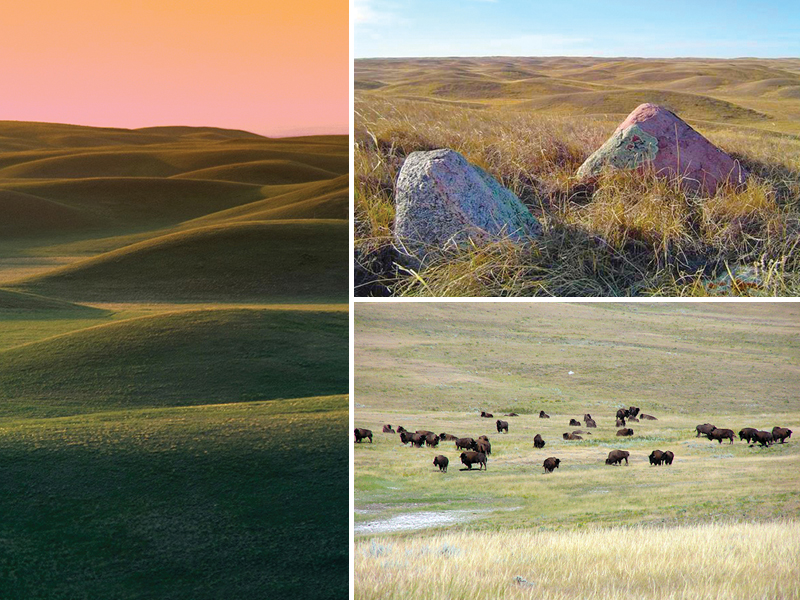
The Old Man on His Back Prairie and Heritage Conservation ranch, features thousands of rolling, hummocky prairie ranch lands that extend to the horizon and into the future. For centuries, many thousands of bison roamed the prairie grasslands. Today’s herd at Old Man on his Back Ranch consists of 80 genetically pure Plains bison. Photos: NCC (landscape); Branimir Gjetvaj (bison)
Hassett says that the upland areas of OMB are native grasslands dominated by Junegrass, Northern Wheatgrass and blue grama, typical of shortgrass prairie communities that comprise these mixed grasslands. Importantly, the region is notable for its lack of invasive species and was secured in 1996 in optimum condition of any tract of shortgrass in Saskatchewan. Endangered species including ferruginous hawk, burrowing owl, loggerhead shrike, and swift fox have been observed on the OMB ranch. Antelope, mule deer, white-tailed deer, and golden eagle may often be viewed in the area.
“Approximately 4,600 acres of the 13,095-acre property is grazed annually by cattle,” says Hassett. “NCC’s grazing management plan at OMB is based on beneficial range management principles such as the variation of the location for salting of livestock on a regular basis and avoidance of riparian areas for better livestock distribution. Subsequently, the use of the livestock watering system by the cattle (instead of natural bodies of water) is encouraged.”
Currently, the NCC’s plains bison herd is 80 animals consisting of 73 cows, four bulls and three calves.
For all those who live and breathe the life of ranching, it is far more than herding cows and taking calves to market. For ranching folk, there exists a rich and ancient connection to the land. They sense the complex rhythm and flow of seasons, the vagaries of weather, the first growth of grass in spring, the replenished water sources after a rain, the birth of calves, the habits of cows, and the quiet dependability of a horse. It’s a connection ranching folk have from the moment they are born. It flows through their veins like streams bubbling through grassland.
It’s their heritage on the hoof.
Main photo courtesy of Lucasia Ranch.



